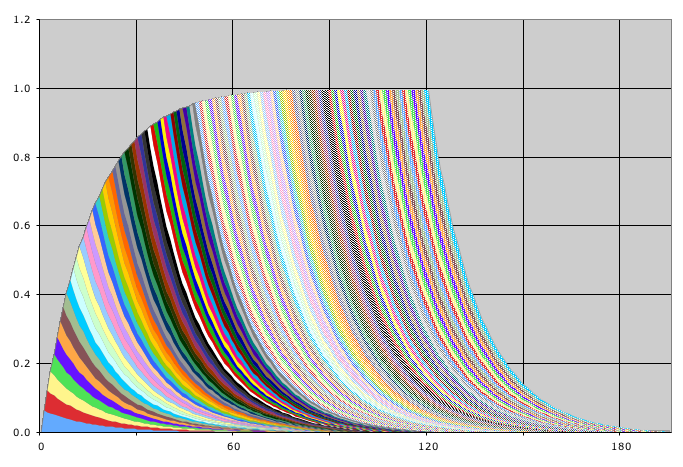After the Congruencies, the Divergences
We have completed constructing the Architecture of Dynamics that lies at the foundation of both material systems and the Living Algorithm's information system. By establishing congruencies, we argued that the notions of energy, momentum, force and work apply to both systems. A series of articles explored how each of these dynamical constructs applied to the Living Algorithm System. Having established congruencies between the two dynamical systems, we now explore the divergences.
Physical and Information Energy: Similarity & Differences
Energy required to change the State of both Systems
We begin our discussion by examining how the notion of energy applies to both systems, material and information. In a prior article we established that energy is required to change the state of both systems. This congruence is where the similarity ends. A major point of departure between the two systems concerns their relationship to energy.
Material Systems: Energy is conserved. Living Algorithm System: Energy is consumed.
There are two fundamental differences between the notion of energy in the two systems. We have spoken at length about one of these differences already. Although material energy goes through many transformations, it is indestructible. This notion is at the heart of energy conservation, the most important law of thermodynamics. Manipulating this equality has provided scientists and engineers with the means of transforming one form of energy into another. This ability has transformed our world in ways that were unimaginable to prior generations. In contrast, energy in the Living Algorithm System is consumed, not conserved. The Living Algorithm System eventually runs down without the addition of new energy.
Energy Exchange in Newtonian Mechanics is Instantaneous & Complete.
The second primary difference between the two systems concerns the exchange of energy. In the material systems of classical Newtonian mechanics that apply so marvelously to the atomic world, energy exchange is instantaneous and complete. This notion is the essence of Newton's second law of motion: every action has an equal and opposite reaction. This important realization is at the heart of many of the equations of Physics. These brilliant equations have allowed us to tap into the potentials of our physical world. The combination of the equalities of 'equal and opposite' and the 'conservation of energy' have proved to be powerful tools for transforming our planet for better or worse.
Energy Exchange in the Living Algorithm System is Gradual & Incomplete.
In contrast, energy transfer in the Living Algorithm System is gradual, rather than instantaneous. This feature is due to the digestive process of the Living Algorithm. The Living Algorithm's digestive method relates moments to each other. This relating process is what makes the Living Algorithm System a dynamical system. An innate feature of the relating process is the gradual transfer of info energy. This feature of info energy has important ramifications in terms of how each system manifests its energy.

Let's examine some graphs to better understand these unusual concepts.
Graph: Contribution of Individual Data Bits to the Attention Pulse
Below is a graphic visualization of the first 20 moments in the Active Pulse, a.k.a. the Pulse of Attention. The data stream that generates this colorful display is a simple series of 20 'ones'. As mentioned in an earlier article, the Pulse of Attention is an acceleration - the second derivative of the data stream. Accordingly, the curved border that joins the multi-colored area together represents the acceleration of the data stream at each moment in time. Each of the color swatches represents the individual contribution of each data point (or instant) to the total acceleration. Accordingly there are twenty color swatches – an acceleration for each moment. Reiterating, a single data bit with the value of 1 spawns each of these mini-accelerations.
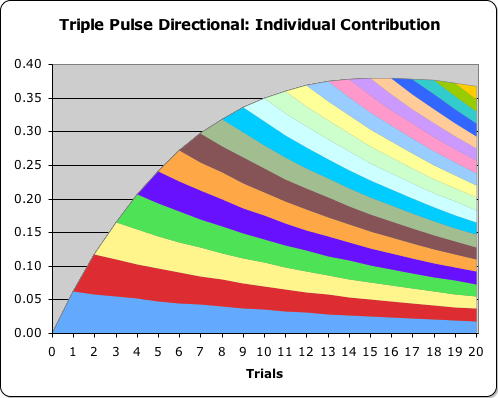
Living Algorithm digestive process spreads decaying Data Energy over time.
There are a few items of note. First, notice how each of the color swatches gradually decays over the twenty moments. This behavior is due to the Living Algorithm's digestive process. This indicates that the complete info energy of each data point (all 1s in this case) is not used up at once, but is instead spread over time. This behavior is completely different from material systems with their complete and instantaneous transfer of energy – their 'equal and opposite' feature.
Accumulation of Individual Accelerations generates a Pulse of Acceleration
The second item is that the acceleration of each individual data point contributes to the whole. Each moment is insignificant by itself. It takes the accumulation of individual accelerations to make a difference. The biggest of the mini-accelerations begins at .06. When the color swatches layer on top of each other to combine forces (literally, as we shall find out), the total acceleration of the data stream eventually rises to .37 – an increase of over 6 times. The accumulation of small contributions by each data bit allows the data stream to generate a Pulse of Acceleration – the foundation of experience. Cooperation brings cumulative results that have emergent properties, not found in the individual accelerations. The interaction of energies creates a cooperative experience that is of a qualitatively different nature than the individual energies from which they are comprised.
Summary: Energy in Material Dynamics vs. Energy in Data Stream Dynamics
Let us summarize the similarity and differences between energy in material systems and energy of the Living Algorithm System. Energy is required to change the state of both systems. In material dynamics, energy is conserved and energy exchange is immediate and complete. In data stream dynamics, energy is consumed and energy exchange is gradual and cumulative. The cumulative feature, itself, of data stream energy reveals an immediate relationship between the individual data points. This interactive element is completely missing from material systems, including electronics.
Dynamics of both Matter & Data Streams: Contrasting Velocity & Acceleration
Besides the notion of energy, the Living Algorithm's relating process has profound implications for the other constructs of dynamics as well. Let us examine what this digestive process means for the rates of change – velocity, acceleration and power.

As discussed in prior articles, these rates of change (derivatives) apply to the dynamics of both matter and data streams. However in these two systems, the nature of the rates of change is entirely different.
Material Rates of Change based upon a simple Subtraction
In material dynamics, velocity and acceleration are instantaneous measures that characterize rates of change at a specific point in time. Rates of change in the material world are based upon a simple subtraction. For instance, acceleration at any point in time is the difference between the current velocity and the prior velocity.
Material Acceleration = Velocity1 - Velocity2 = ∆Velocity (∆ = change)
Material Velocity can be visualized as a Slope
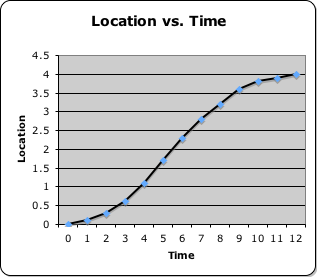
Material rates of change can be visualized as a slope - the ratio of the change to the time duration. For instance, our car's speed - the number of miles traveled per hour, is a rate of change. Our speedometer reflects this speed on a moment-to-moment basis. In the graph at right, we plot location against time. The slope of the line represents the speed of our car. The flat slope in the beginning indicates a slow speed. The sharper slope in the middle indicates more distance is covered in a shorter time – a greater speed. The flat slope at the end indicates the car is slowing down. As is evident, the slope or incline of the line represents the speed of the car - the rate of change in location. The same analysis applies to the rate of change in velocity - acceleration, and the rate of change in work – power. In each case, the slope of the line (based upon a simple subtraction of the appropriate measure) indicates the rate of change. This is not the case in data stream dynamics.
Data Stream Rates of Change based upon Accumulations
In data stream dynamics, rates of change, such as velocity and acceleration are cumulative. At right is a picture of the accumulating contributions of the individual data bits to the total velocity of the data stream. Shown earlier was a similar visualization of the data stream's acceleration. A simple subtraction does not relate moments together. The relating process requires a residue from what went before. Data Stream Velocity and Acceleration are an accumulation of all the individual velocities and accelerations that went before. This relating process is why the Living Algorithm's transformations behave in a living manner - with each part having an effect upon the whole.
Sometimes Accumulations result in a Pulse
When the data stream's rate of change is an acceleration, the result of these accumulations can be a pulse – illustrated above. However they manifest, the measures of the data stream's rates of change can not be accurately characterized as slopes. Slopes only provide a rough approximation of the value of these rates of change.

Summarizing: Material Systems and the Living Algorithm System belong to the same structure of dynamics, which is based upon rates of change (derivatives). The rates of change in material systems are computed with a simple subtraction, which can be visualized as a slope. In contrast, rates of change in the Living Algorithm System are cumulative, which sometimes manifest as a pulse.
Material Systems, a special subset of Living Algorithm System
Living Algorithm Algebra: If the Decay Factor = 1, Then No Past, No Relationship and No Dynamics.
To make better sense of these differences, let's take a brief look at the Living Algorithm with her components.
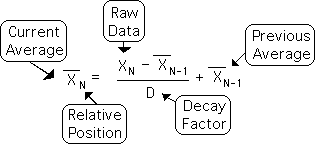
The Living Algorithm's digestive process mixes the Raw Data with the Past (the Previous Average) to generate the Present (the Current Average). D, the Decay Factor, is a key component of the Living Algorithm process that creates a relation between the Past and the Present. However the Decay Factor must be greater than 1 (D>1) for this relating process to occur. Look what happens when the Decay Factor equals 1 (D=1).
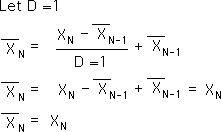
When the Decay Factor is one, the past drops out of the equation. The current average is merely the raw data. There is no accumulation, hence no relationship between the points and hence no dynamics. We are instead left with the inert, undigested, raw data. What are the implications of the elimination of the influence of the past on current events?
Specialists in Material Systems only deal with Inert Raw Data
Let's start with the notion that material systems only generate inert, undigested, raw data. Scientists gather this raw data as a permanent reflection of some particular feature of reality that is of interest. The relative precision of this data is guarded and archived for reference at a later date. Perhaps it is even translated into an eternal digital form that can be accessed by anyone in the world via the Internet. The specialists in material systems only deal with inert, undigested raw data. The implicit assumption is that this data won't decay, nor will its neighbors affect its precise value. It just is. Similarly, when the Decay Factor is one (D=1), the data just is. In both cases the raw data is inert and undigested. Viewed in this light Material Systems are, in fact, a special subset of the Living Algorithm System. Material Systems represent the special state when D, the Decay Factor, equals one.
Material and Info System participate in the same dynamical structure in a different way.
Both systems participate in the same dynamical structure. However, each system participates in the dynamical structure in an entirely different fashion. This significant difference is due to the fact there is no relationship between the individual data points in material systems. This feature has a mathematical reason. The relationship between points is eliminated when the Decay Factor is one (D=1). The past is eliminated as a factor in the Living Algorithm's computations. If there is no memory of the past, there is no relationship - no decay - no dynamics. The information is inert. Perfect for material systems. When the Decay Factor is greater than one, the past becomes a factor and the information is dynamic. This is perfect for living systems, as they require a decaying relationship with the past in order to make sense of current events. This knowledge allows the organism to make a more appropriate response to environmental stimuli.

Material Systems, such as Electronics, require Inert Data
This permeability between past and present is unacceptable in material systems. When the Decay Factor is one, the past is eliminated as a factor. Standing alone the data bit is indestructible. Its entire energy is transformed immediately and completely from one form to another. This process applies to material systems, such as electronics. Accordingly information in material systems is inert, without a dynamic feature. In fact, we prefer for it to be that way. To crystallize understanding, let's investigate an everyday example.
Why Electronic Information must be inert: the CD Example
CD's electronic storage requires exact transmission
The Compact Disc (a CD) provides a great example of why we want our electronic information to be inert. We store documents, photographs, music, and movies on CDs in a precise and permanent digital form. For instance when we share our digital media with others, perhaps music with a friend, we depend on the fact that the electronic transfer will be exact and complete. Further, we hope that when the sensory data is translated into a digital form that it approximates reality as accurately as possible. For instance, we want our electronic recordings to sound like the live performance.
Electronic Data: permanent and unaffected by neighboring Data
We would hate for any of this electronic information to decay in any way at any point in the process. We share and download movies, music and pictures that are all exact digital replicas of each other - no degeneration. Only the physical storage units, such as a computer hard drive, degenerates, not the information. This is why we are cautioned to back up our files. It is evident that accurate and permanent transmission is the key in digital electronics. As such, we require that electronic data be permanent and unaffected by its neighboring data.
Electronic Info: Static, no dynamics – no illusion of motion
The reasonable requirement that our electronics be permanent and stable results in a static system of information – no dynamics. Stringing together a series of static and permanent instants creates the illusion of motion. But the digital information does not move at all. In fact if we processed information like a computer, we would not see motion either. Electronic information is inert. A CD, an electronic storage unit, just sits there, not moving at all. The digital information resides in the absolute present. There is no past.
Why our Illusion of Motion requires the Living Algorithm's Dynamic Information
Living Algorithm System leaves traces of what went before.
How do we see movement in these static slices of instants in time? Our method of digesting information creates the illusion. As mentioned and demonstrated above, each moment leaves traces. The immediate impact of each instant fades with time. These traces are the essence of the relating process. And it is these traces that create the illusion of motion by referencing the past. By leaving trails, the moments are connected in a dynamic fashion. Electronic processing does not create this result. This connectivity is the result of the Living Algorithm's method of digesting information.
Living Systems require a Digestive System where Information Decays
Although we demand static permanence from our electronic information, we also require a digestive system where the information decays. For instance, if it didn't decay, all the sounds or images would be piled up on top of each other. Decay is required so that one image or sound fades as it is supplanted by the next, which begins fading as it is supplanted by the next, and so on. In this way the most recent image takes precedence, but still retains traces of what went before – the past. As mentioned, these traces contain the essential continuity that provides meaning to the flow of environmental information.
Static Information of Electronics balanced by Living Algorithm's Dynamic Information
We need our electronic processing system to be permanent and static to transmit identical information from place to place. The transmission must be exact. To perceive the auditory or visual motion (music or movies) that is contained in these forms of static electronic information, we require a digestive system to relate information, past to present, in a dynamic fashion. The Living Algorithm provides this service. As such, the static information of electronics and the Living Algorithm's dynamic information balance each other. One system provides the stability of permanence; the other provides the dynamics of change.

To Live & Interact is to Decay & Die
However, there is a catch. The Living Algorithm provides the connectivity that living systems require to make sense of our dynamic world. However, the Living Algorithm's relating process is based in decay (a Decay Factor greater than one – D > 1). In contrast, the energy and data of material systems can be eternal, as the past is not a factor because the Decay Factor equals one (D = 1). The Living Algorithm's dynamic digestive system that decays yields the transitory nature of Life - an internal universe that is in a constant state of flux. As soon as the Decay Factor shifts from 1 to 2, we are connected with our world and simultaneously begin to decay. To live and interact is to decay and die.

Summary
Summarizing: In prior articles we established that material systems and the Living Algorithm's information system share a common dynamical structure. By analyzing symmetries, we showed that the constructs of energy, work and power apply to both systems. In this article we explored where the two systems diverge. In material systems, energy is conserved and energy exchange is instantaneous. In the Living Algorithm System, energy is consumed and energy exchange is gradual. In material systems, rates of change, such as velocity and acceleration, are computed with a simple subtraction – the difference between the past and the present. In the Living Algorithm System, rates of change are based upon accumulations of past events that have been scaled in relation to the present.
Electronic Information Static; Living Algorithm Information Dynamic
In material systems such as electronics, information is permanent and unaffected by the neighboring data. As such electronic information resides in the eternal present with absolutely no connection to the past. In contrast to a digital system, information decays in the Living Algorithm System. Or more precisely, the Living Algorithm’s digestive process spreads the influence of the data over time. It is these residuals that connect the past with the present. Could this relating process be at the basis of memory and learning that is required by living systems? It turns out that information in material systems is a special subset of the Living Algorithm System – when the Decay Factor equals one (D=1).
Links
We have explored the convergences and divergences between the dynamics of material systems and the Living Algorithm System. To understand how the Living Algorithm System integrates the constructs of dynamics, check out the next article in the series – Integration: Living Algorithm Dynamics.
